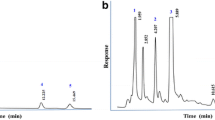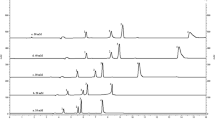Abstract
Kaempferol, apigenin, rutin, quercetin, luteolin and ferulic acid are separated and detected in Chinese herbal tea using capillary zone electrophoresis coupled to amperometric detection. The phosphate running buffer also contains ß-cyclodextrin (ß-CD), which assists in separation and gives excellent separations within 20 min and detection limits as low as 10 ng mL−1 (S/N = 3). The effects of working electrode potential, pH and concentration of running buffer, concentration of ß-CD, separation voltage and injection time were investigated. The method was applied to analyze tea samples with recoveries in the range of 90.0 to 107.0%. The method offers high separation efficiency, short analysis time, small sample consumption, and good repeatability.



Similar content being viewed by others
References
Liu FJ (2003) Features and sources of local tea-custom in Guangdong Province. J GuangDong Polytech Norm Univ 1:68
Xian JM, Yao H (2005) Simply analyse the herbal tea culture and rheology of Guangdong. Diet Cult Res 4:100
Rijke E, Out P, Niessen WMA, Ariese F, Gooijer C, Brinkman UAT (2006) Analytical separation and detection methods for flavonoids. J Chromatogr A 1112:31
Proestos C, Boziaris IS, Nychas GJE, Komaitis M (2006) Analysis of flavonoids and phenolic acids in Greek aromatic plants: investigation of their antioxidant capacity and antimicrobial activity. Food Chem 95:664
Havsteen BH (2002) The biochemistry and medical significance of the flavonoids. Pharmacol Ther 96:67
Heim KE, Tagliaferro AR, Bobilya DJ (2002) Flavonoid antioxidants: chemistry, metabolism and structure-activity relationships. J Nutr Biochem 13:572
Stalikas CD (2007) Extraction, separation, and detection methods for phenolic acids and flavonoids. J Sep Sci 30:3268
Wang SP, Huang KJ (2004) Determination of flavonoids by high-performance liquid chromatography and capillary electrophoresis. J Chromatogr A 1032:273
Karapanagiotis K, Lakka A, Valianou L, Chryssoulakis Y (2008) High-performance liquid chromatographic determination of colouring matters in historical garments from the Holy Mountain of Athos. Microchim Acta 160:477
Surowiec I, Nowik W, Trojanowicz M (2008) Post-column deprotonation and complexation in HPLC as a tool for identification and structure elucidation of compounds from natural dyes of historical importance. Microchim Acta 162:393
Schieber A, Keller P, Carle R (2001) Determination of phenolic acids and flavonoids of apple and pear by high-performance liquid chromatography. J Chromatogr A 910:265
Liu ZM, Niwa O, Kurita R, Horiuchi T (2000) Miniaturized thin-layer radial flow cell with interdigitated ring-shaped microarray electrode used as amperometric detector for capillary electrophoresis. J Chromatogr A 891:149
Diaz AMC, Lorenzo-Ferreira RA, Cela-Torrijos R (1996) Validation and quality control of methylmercury determinations by means of capillary electrophoresis. Microchim Acta 123:73
Volpi N (2004) Separation of flavonoids and phenolic acids from propolis by capillary zone electrophoresis. Electrophoresis 25:1872
Cao YH, Wang Y, Yuan Q (2004) Analysis of flavonoids and phenolic acid in propolis by capillary electrophoresis. Chromatogr 59:135
Xu XQ, Yu LS, Chen GN (2006) Determination of flavonoids in Portulaca oleracea L. by capillary electrophoresis with electrochemical detection. J Pharm Biomed Anal 41:493
Cao YH, Zhang X, Fang YZ, Ye JN (2001) Determination of active ingredients of apocynum venetum by capillary electrophoresis with electrochemical detection. Microchim Acta 137:57
Chu QC, Wu T, Fu L, Ye JN (2004) Determination and comparison of phytoestrogens in both crude and parched flos sophorae immaturus by capillary electrophoresis with electrochemical detection. Microchim Acta 148:311
Gomez DG, Cohen D, Dickerson JA, Chen XG, Canada FC, Dovichi NJ (2009) Improvement in protein separation in Barretts esophagus samples using two-dimensional capillary electrophoresis analysis in presence of cyclodextrins as buffer additives. Talanta 78:193
Fanali S (2000) Enantioselective determination by capillary electrophoresis with cyclodextrins as chiral selectors. J Chromatogr A 875:89
Tagliaro F, Manetto G, Bellini S, Scarcella D, Smith FP, Marigo M (1998) Simultaneous chiral separation of 3, 4-methylenedioxymethamphetamine (MDMA), 3–4 -me thylenedioxyamphetamine (MDA), 3, 4 -methylenedioxyethylamphetamine (MDE), ephedrine, amphetamine and methamphetamine by capillary electrophoresis in uncoated and coated capillaries with native P-cyclodextrin as the chiral selector: preliminary application to the analysis of urine and hair. Electrophoresis 19:42
Zerbinati O, Trotta F (2001) Cyclodextrin-assisted capillary electrophoretic resolution of 1, 1’-bi-2-naphthol atropisomers. Electrophoresis 22:3578
Chankvetadze B, Lomsadze K, Burjanadze N, Breitkreutz J, Pintore G, Chessa M, Bergander K, Blaschke G (2003) Comparative enantioseparations with native β-cyclodextrin, randomly acetylated β-cyclodextrin and heptakis-(2, 3-di-O-acetyl)-β-cyclodextrin in capillary electrophoresis. Electrophoresis 24:1083
Cheung HY, Zhang QF (2008) Enhanced analysis of triterpenes, flavonoids and phenolic compounds in Prunella vulgaris L. by capillary zone electrophoresis with the addition of running buffer modifiers. J Chromatogr A 1213:231
Mofaddela N, Krajian H, Villeminb D, Desbène PL (2008) Enantioseparation of binaphthol and its mono derivatives by cyclodextrin-modified capillary zone electrophoresis. J Chromatogr A 1211:142
Müller U, Mrestani Y, Neubert R, Dräger B (2008) Chiral separation of the plant lignan matairesinol by capillary electrophoresis. Electrophoresis 29:3582
Zhang S, Dong SQ, Chi LZ, He PG, Wang QJ, Fang YZ (2008) Simultaneous determination of flavonoids in chrysanthemum by capillary zone electrophoresis with running buffer modifiers. Talanta 76:780
Chankvetadze B (2004) Combined approach using capillary electrophoresis and NMR spectroscopy for an understanding of enantioselective recognition mechanisms by cyclodextrins. Chem Soc Rev 33:337
Wang QJ, Ding F, Zhu NN, Li H, He PG, Fang YZ (2003) Determination of hydroxyl radical by capillary zone electrophoresis with amperometric detection. J Chromatogr A 1016:123
Dong SQ, Chi LZ, Zhang S, He PG, Wang QJ, Fang YZ (2008) Simultaneous determination of phenylenediamine isomers and dihydroxybenzene isomers in hair dyes by capillary zone electrophoresis coupled with amperometric detection. Anal Bioanal Chem 391:653
Huie CW (2003) Effects of organic solvents on sample pretreatment and separation performances in capillary electrophoresis. Electrophoresis 24:1508
Idei M, Kiss É, Dobos Z, Hallgas B, Mészáros G, Hollósy F, Kéri G (2003) Separation of anti-tumor peptides by capillary electrophoresis in organic solvent containing background electrolytes. Electrophoresis 24:829
Lo CK, Paau MC, Xiao D, Choi MMF (2008) Application of capillary zone electrophoresis for separation of water-soluble gold monolayer-protected clusters. Electrophoresis 29:2330
Chicharro M, Sánchez A, Zapardiel A, Rubianes MD, Rivas G (2004) Capillary electrophoresis of neurotransmitters with amperometric detection at melanin-type polymer-modified carbon electrodes. Anal Chim Acta 523:185
Acknowledgements
This work was financially supported by Science and Technology Commission of Shanghai (No.08142201400).
Author information
Authors and Affiliations
Corresponding authors
Electronic supplementary material
Below is the link to the electronic supplementary material.
ESM1
(DOC 80 kb)
Rights and permissions
About this article
Cite this article
Chi, L., Li, Z., Dong, S. et al. Simultaneous determination of flavonoids and phenolic acids in Chinese herbal tea by beta-cyclodextrin based capillary zone electrophoresis. Microchim Acta 167, 179–185 (2009). https://doi.org/10.1007/s00604-009-0229-0
Received:
Accepted:
Published:
Issue Date:
DOI: https://doi.org/10.1007/s00604-009-0229-0




